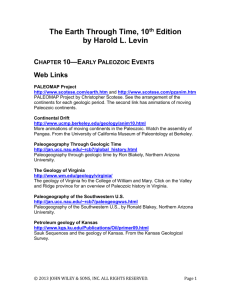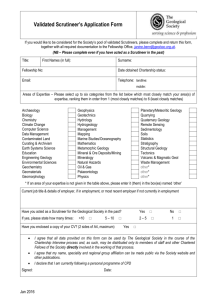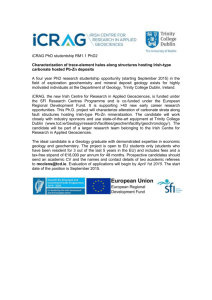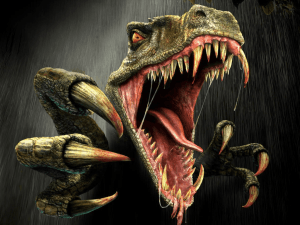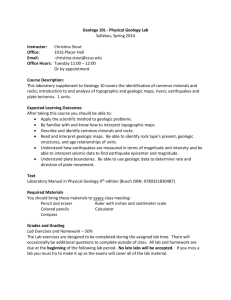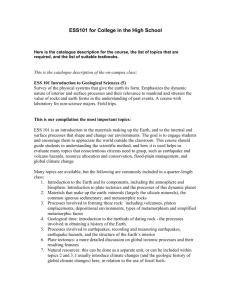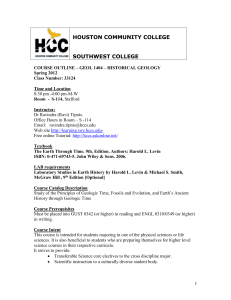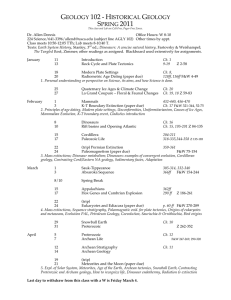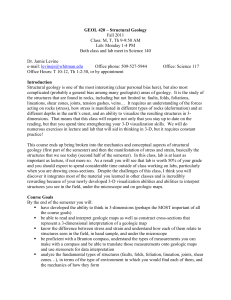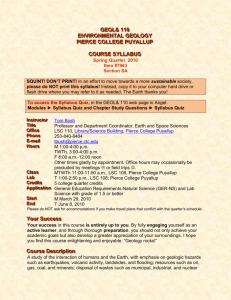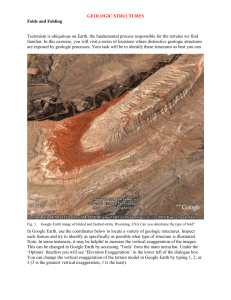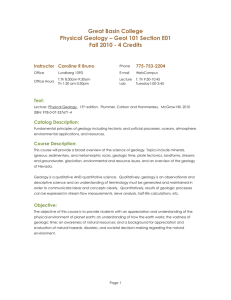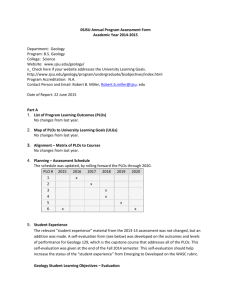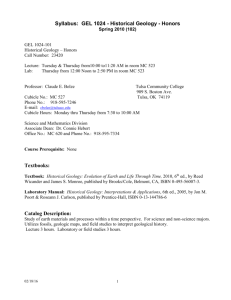GL102 - Mohawk Valley Community College
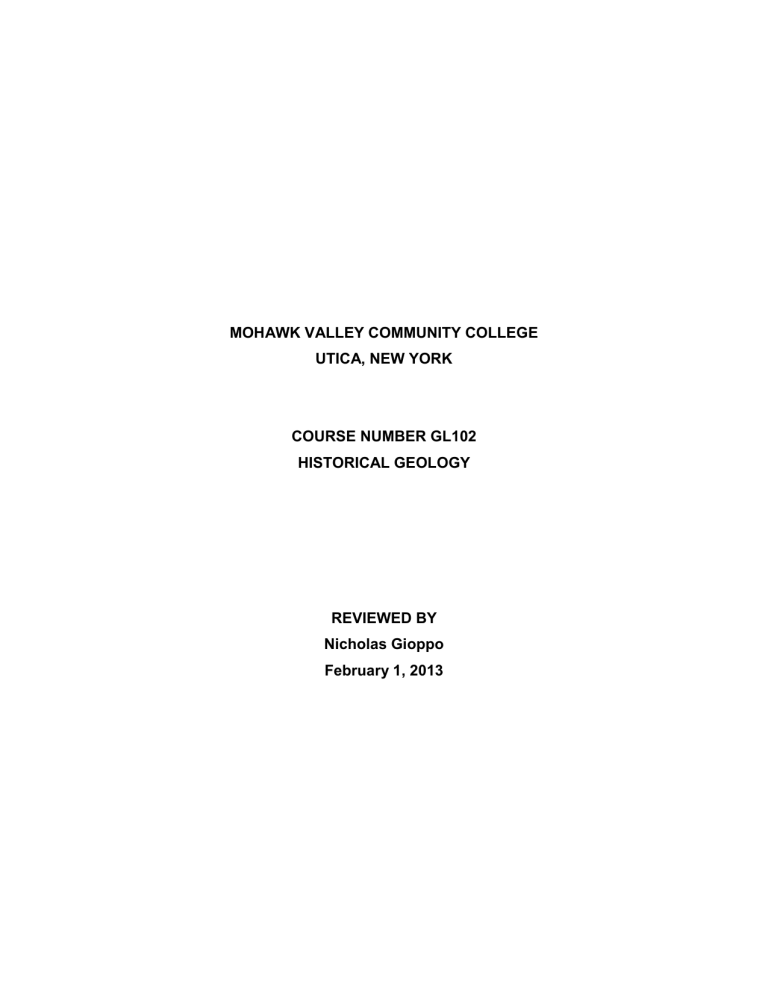
MOHAWK VALLEY COMMUNITY COLLEGE
UTICA, NEW YORK
COURSE NUMBER GL102
HISTORICAL GEOLOGY
REVIEWED BY
Nicholas Gioppo
February 1, 2013
Course Number: GL102
Course Title: Historical Geology
Credit Hours: 4
COURSE OUTLINE
I. Course Description
Historical Geology examines the physical and biological changes that have occurred on the earth throughout it’s four and a half billion years of existence.
The class begins by looking at the how the earth came to be, as well as its place in the universe. From there the earth is examined compositionally and structurally. Once that background is laid, we spend the balance of the semester discussing the development of organisms & their interactions with the earth. It is important to note, that while the primary focus of the class will be aimed at the study of organisms over time, the geologic setting of these changes will also be illustrated. Topics to include: geologic time, fossilization, organic evolution, as well as the study and identification of plants, invertebrates, and vertebrates including, dinosaurs and man.
The laboratory portion of the class suits two purposes: first, it is used to take many lecture topics to the next level for a more in depth study. Additionally, it can be used as the primary learning environment for other activities such as rock and fossil identification and map interpretation which are best explored in a
“hands on” manner.
II.
Course Objectives
Lecture
A. The student will be able to describe the basic scientific and geological principles that govern modern geology and paleontology.
B. The student will be able to describe how science is an investigative process.
C. The student will demonstrate an understanding of the importance and necessity of organic evolution.
D. The student will demonstrate an understanding of the interconnectedness of the physical evolution of the earth and the above mentioned organic evolution.
E. The student will demonstrate an understanding of the necessity of deep tim e to achieve the earth’s current state.
E. The students will be able to illustrate the early evolution of the earth as it concerns the original of life on earth.
Laboratory
A. The student will use hierarchal keys and other pertinent scientific literature to classify and identify the major categories of vertebrates in the laboratory environment.
B. The students will be able to identify major evolutionary changes made to the vertebrates over time.
C. The student will apply the knowledge gained in the laboratory environment to classify and identify specimens in a museum setting.
III. Organization and Procedures
A. Time Allotment (4 credit hours)
1.
2.
Lecture: 3 hours per week for 15 weeks
Laboratory: 2 hours per week for 15 weeks
B. Placement:
1. Spring semester
C. Facilities:
1. Lecture room sufficient for 40 students
2.
3.
4.
Complete laboratory facility for 16 students
Geologic reference materials
Audio/Video/Computer Equipment for both lecture & laboratory sections of the class in order to best convey course content. Methods include Power Point presentations by faculty & students, internet content & DVD/VHS video content.
5. Lab facilities for cleaning, preparing & storing geologic specimens as well as topographic maps and charts.
D. Teaching Methods
1. Lecture-discussion
2.
3.
4.
Supervised laboratory work
Laboratory demonstrations
Off-campus field trips during laboratory periods
& weekends
4.a. Mandatory field trip to the American Museum of Natural
History, in NYC
5. Individual conferences when necessary
E. Evaluation
1. Lecture a. Hour examinations 3 – 4 non-comprehensive
2. b. Final exam 1 comprehensive examination
Laboratory a. 15 weekly laboratory projects or experiments b. 3 formal laboratory write ups of experiments c. 2 laboratory practicals d. Group project based on field trip data
F. Instructional requirements, grading and attendance policy to be provided by instructor.
IV. Required Materials
A. Texts
Lecture (Required)
Historical Geology 7 th Edition, by: Wicander & Monroe
Laboratory (Required)
Handouts provided by instructor, a 3-ring binder is required
GEOLOGY 102 HISTORICAL GEOLOGY
LECTURE OUTLINE
Chapter 1:
Chapter 2:
Chapter 3:
Chapter 4:
Time and Terrestrial Change
Floods, Fossils, and Heresies
Evolution
The Relative Geologic Time Scale and Modern Concepts of
Stratigraphy
Chapter 5:
Chapter 6:
The Numerical Dating of the Earth
The Origin and Early Evolution of the Earth
Chapter 7:
Chapter 8:
Mountain Building and Drifting Continents
Precambrian History An Introduction to the Origin of
Chapter 9:
Continental Crust
Early Life and Its Patterns
Chapter 10:
Chapter 11:
Earliest Paleozoic History: The Sauk Sequence
An Introduction to Cratons and Epeiric Seas
The Later Ordovician: Further Studies of Plate Tectonics and the Paleogeography of Orogenic Belts
Chapter 12: The Middle Paleozoic: Time of Reefs, Salt, and Forests
Chapter 13: Late Paleozoic History: A Tectonic Climax and Retreat of the
Sea
Chapter 14: The Mesozoic Era: Age of Reptiles and Continental Breakup
Chapter 15: Cenozoic History: Threshold of the Present
Chapter 16: Pleistocene Glaciation and the Advent of Humanity
Chapter 17: The Best of All Possible Worlds?
Appendix I: The Classification and Relationships of Living Organisms
GEOLOGY 102 HISTORICAL GEOLOGY
LABORATORY OUTLINE
Week
6
7
8
9
10
11
12
13
14
15
3
1
2
4
5
Topic
Fossilization
Classification: Linnaeus & Cladistics
Introduction to Invertebrates
Survey of Invertebrates
Survey of Invertebrates
Introduction to Vertebrates
The Fishes
The Amphibians
The Reptiles
The Dinosaurs
Morphometrics
Dinosaurs of the AMNH
Dinosaurs of the AMNH
Dinosaurs of the AMNH
Final Projects
